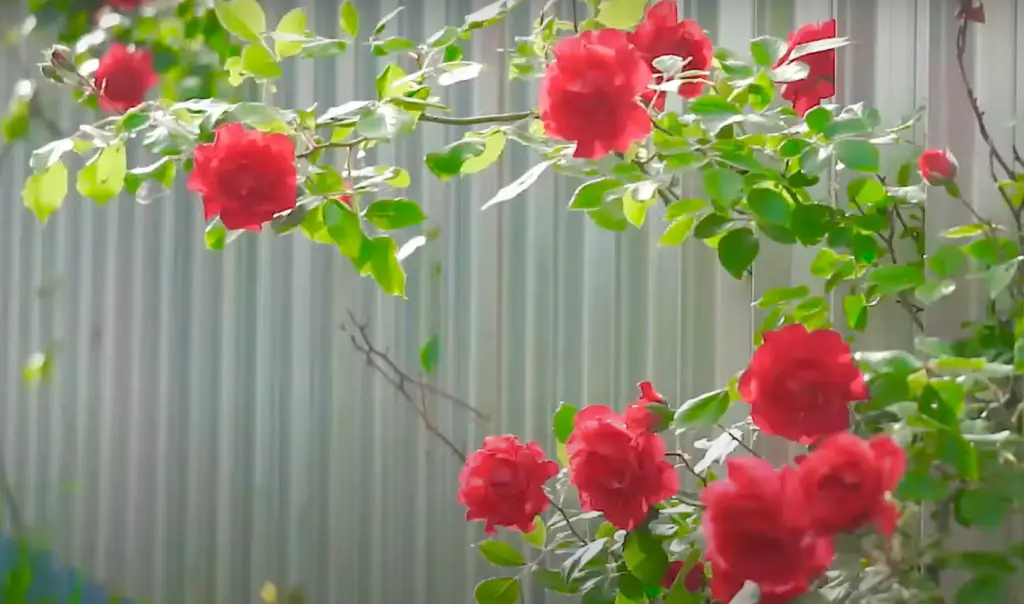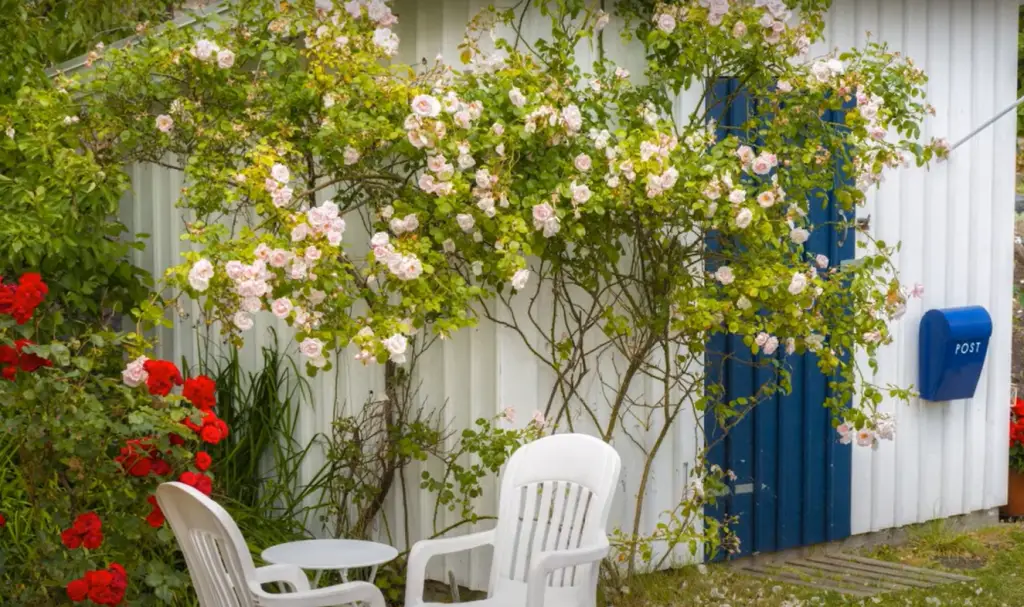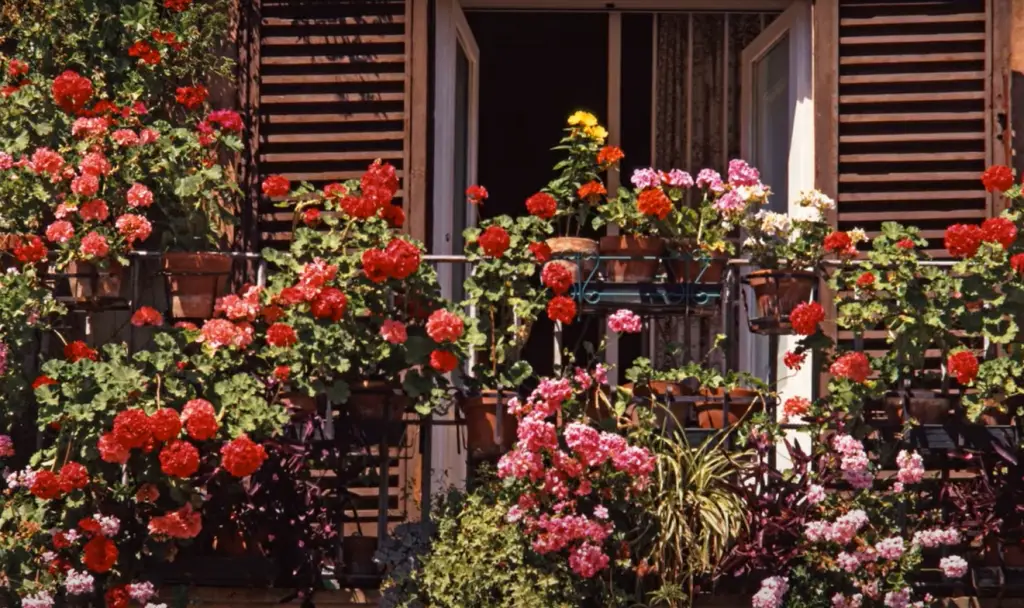Climbing roses are a beautiful and popular addition to any garden, but they can be tricky to support. Without the right structure in place, they can become unruly and even damaging to other plants. Fortunately, there are plenty of creative solutions for supporting climbing roses that will not only keep them safe and secure but also enhance their beauty. From simple trellises to elaborate arches, this article will provide you with some great ideas for giving your climbing roses the perfect support system. So if you’re looking for inspiration on how best to care for your flowering vines, read on!
Lattice Rose Trellis with Wooden Frame
A lattice rose trellis with wooden frame is an ideal option for supporting climbing roses.
This type of trellis can be made in any size and shape, allowing you to customize it to your garden’s unique needs. To make one, simply build a frame out of wood and cover with lattice material such as chicken wire or plastic mesh. Secure the trellis to the ground using stakes or other anchors for extra stability.Crimson Rose Climbing Through Metal Wire Trellis
A metal wire trellis makes an excellent support for a climbing rose. It provides the necessary structure and space for the rose to grow, as well as a beautiful backdrop that adds charm to any garden or outdoor area. The best way to set up a metal wire trellis is to attach it securely to two posts in the ground.

The trellis should then be secured to the posts using galvanized wire and also staked into the ground if necessary. Once it is properly installed, you can train your rose to climb up the trellis by wrapping its shoots around the wires in a spiral pattern. With proper care and maintenance, this type of support will help your roses reach their maximum potential. Not only will it look beautiful, but it will also provide your roses with the support they need to thrive and bloom for years to come. [1]
Turn a Bicycle Rim into a Rose Trellis
Do you have an old bicycle rim? It can be used to make a great trellis for climbing roses. To do this, start by cutting the bicycle rim in half and then use wire to secure it at the top of a sturdy post or wooden stake. Next, attach eye bolts evenly around the circumference of the rim and secure them with nuts. Finally, use steel cable to attach the climbing roses to the eye bolts. With this simple trellis in place, you can give your climbing roses the support they need. Plus, it’s an environmentally friendly and creative way to reuse something that might otherwise end up in a landfill!
Wooden Stake for Climbing Roses
A wooden stake may be the simplest and most cost-effective way to support a climbing rose. To use it, simply insert the wooden stake into soil near the base of the rose bush.

Tie one end of a garden twine or soft cloth around the top of the stake, then wrap it around each stem as you guide it upward and around the stake. This will help keep stems upright and give them something to cling to as they grow. It is a good idea to check on your climbing roses each season and adjust the stake if needed.
Tall Tower Trellis for Garden Roses
A tower trellis is the perfect way to support your garden roses. This style trellis is great for climbing varieties, which need vertical space to grow upwards. The tower gives your roses plenty of to reach their full height, while providing an aesthetically pleasing backdrop for them. You can make a tower trellis out of wood, metal, or PVC pipe. It’s important to use materials that are strong enough to support the weight of your roses as they grow and mature. Be sure to install your trellis securely in the ground so it can’t be toppled over by wind or other forces. Once you have your trellis in place, you can train your roses to climb up it using wires or strings. This will help them reach their full potential and get the most out of their climbing habit.
Your garden roses will look beautiful as they grow and bloom on this tower trellis! Not only is it a great way to add more height to your garden, but it also creates a stunning focal point for any outdoor space. Plus, the tower offers extra protection from strong winds that can damage delicate blooms. With proper maintenance and care, you will enjoy show-stopping roses for many years to come! [2]
Roses Across the Wire Rope Trellis
A wire rope trellis is a great way to support climbing roses. The basic design of the trellis consists of a set of wires that are suspended between two posts, and the rose stems can be woven through them as they grow up and along the structure. Wire rope trellises are strong enough to support even the heaviest climbers, and they look attractive in the landscape. They are also easy to assemble, so you don’t need any special tools or skills to set them up.

Wire rope trellises can be made from a variety of materials, including wood, metal, and plastic. Choose one that is suited for your climate and rose variety, as some may require more protection from the elements than others. The spacing of the wires should be wide enough for your climbers to weave their stems through, while also allowing light and air circulation to reach the plant’s foliage.
DIY Wall Trellis for Pretty Pink Roses
A DIY wall trellis is a great way to provide some extra support for your climbing roses. This simple project requires just a few supplies, and it can make a big difference in the overall health of your roses. Here’s how to build one:
- Start by gathering your supplies. You will need 4-by-4 posts, a drill and screws, as well as some rope or string for tying the roses to the trellis. You’ll also need a saw to cut the posts if needed, and garden clippers for trimming the roses.
- Determine where you want to place the trellis. Measure and mark the area, then dig two holes for your posts. Make sure the holes are deep enough so that when you place the posts in them, they will be secure and stable.
- Place the posts in the holes and fill them with dirt. Make sure that they are firmly packed in place before continuing.
- Drill two holes, one at the top and one at the bottom of each post. Then use screws to attach pieces of rope or string vertically from top to bottom.
- Finally, use garden clippers to trim your roses and tie them to the trellis with pieces of rope or string. Be sure to check the roses periodically and re-tie them if needed. [3]
Climbing Pink Roses on Pastel Blue Wall
A climbing pink rose on a pastel blue wall is a stunning addition to any garden. Whether you’re looking for an elegant, romantic aesthetic or just want to add a pop of color and texture, these roses are the perfect choice.

When choosing support ideas for your climbing roses, it’s best to consider the size and shape of the roses you have. If you are planting smaller varieties, such as climbing tea roses, a trellis or metal arbor can provide ample support and an elegant look. On the other hand, if you’re using larger climbing roses, like hybrid teas and floribundas, they may need sturdier structures to hold their weight. Options such as metal arbors, wooden pergolas, and lattice walls can provide the support needed for your climbing roses to thrive.
Metal Arbor for a Rosy Canopy in the Yard
A metal arbor provides an elegant and functional solution when it comes to supporting climbing roses in the garden. This type of structure adds a touch of romance, while also providing sturdy support for rose vines as they climb and twine around the posts. Metal arbors are available in many styles, ranging from classic lattice designs to elaborate gazebo-inspired shapes.
Additionally, many metal arbors come with matching benches so you can enjoy the beauty of your climbing roses even more!Train Them along The Garden Gate
A popular design feature in gardens is the use of climbing roses trained along a garden gate. This idea can be used to create a beautiful entry point and add an extra layer of privacy to any outdoor area. The trick is selecting the appropriate rose cultivar and ensuring it’s properly supported throughout its growth cycle.

When planting, make sure to dig a hole twice as large as the root ball and line it with fertilizer for extra nourishment. Use trellis, stakes or wire mesh to give your roses something to cling on to as they grow up the gate. Prune your roses regularly to ensure healthy growth, but be careful not to over-prune them. Deadheading flowers is also essential for encouraging additional flower production. [4]
FAQ
What is the best support for a climbing rose?
The best support for a climbing rose will depend on the size, weight, and desired effect of your rose. For light climbers, such as some varieties of Miniature Roses or Climbing Floribunda Roses, trellises, obelisks, or arches are all great options. They can be made of wood, metal, or plastic, and they add an aesthetically pleasing addition to your rose garden. For larger climbing roses, such as Hybrid Tea Roses or Climbing Hybrid Teas, a sturdy obelisk, archway, or wall trellis will be more suited for the task. These should be sturdily secured in the ground with braces at the base for added support.
How do you build support for climbing roses?
Building support for climbing roses can be done using a variety of methods. The most common methods include trellises, arbors and walls. Trellises are an ideal support for climbing roses as they provide an attractive and easy to build structure. Trellises should be placed in a sunny spot, and can be secured in the ground with stakes. They should also be fitted with netting or wires to help the rose climb up the structure. Arbors are a more permanent solution for supporting climbing roses, and can be an attractive feature in any garden. Arbors should be made of heavy-duty materials such as metal or timber, and should be secured in the ground. They can also be fitted with trellis panels to provide additional support for climbing roses. Walls can also be used as a form of support for climbing roses. Wall-mounted brackets can be used to secure the roses, while a combination of cables and trellis panels can provide additional stability. When installing climbing roses onto walls, it is important to use fixings that are suitable for the wall material.
How do you stabilize climbing roses?
When stabilizing climbing roses, you have a few options to choose from. The best way is to install sturdy posts or trellises to provide strong support for the roses. Posts should be spaced around 6–8 feet apart and should be sunk into the ground at least a foot deep to ensure that they are securely in place. You can also use a wall or fence as a strong support, if available. Other options include using wires and wires strung between posts, or securing the stems of the roses to a wall or trellis with soft garden ties. Whichever option you choose, make sure that there is enough support to sustain the weight of the roses and their branches. Finally, pruning the plant regularly helps keep it in shape and encourages the plant to produce more flowers.
What trellis is best for climbing roses?
When it comes to selecting the best trellis for your climbing rose, there are a few things to consider. Firstly, you’ll need to think about the size and shape of trellis that will provide the most stability, as well as accommodate the growth and spread of your rose. A metal, lattice-style trellis can be a good choice as it will provide the necessary stability and support for your climbing rose. It’s also important to choose a trellis that is made from a weatherproof material so that it can remain sturdy and look great for years.
Do climbing roses have to be supported?
Climbing roses can grow without support, but providing them with some form of structure will help to promote healthier growth and more blooms. Without adequate support, climbing roses can become leggy and lack the dense foliage and full blooms that come with proper support. To get the most out of your climbing roses, it’s best to provide them with some form of support.
Should I use a trellis for roses?
A trellis is a great way to support climbing roses and other vining plants. It provides sturdy, upright support that will keep the stems of the plants from drooping or sagging. It also creates a defined visual structure and can be used to create an attractive garden feature.
 Trellises can be made from a variety of materials, such as metal, wood, or plastic. When selecting a trellis for your roses, make sure it is sturdy enough to support the weight of the mature plant and that it is tall enough for the roses to climb. Additionally, you may want to consider adding a cross-support for extra stability. If you do not have space or resources for a trellis, there are other ways to provide support for your climbing roses. A sturdy archway or pergola is a great alternative, as it will add beauty and structure to your garden, while providing support for the roses.
Trellises can be made from a variety of materials, such as metal, wood, or plastic. When selecting a trellis for your roses, make sure it is sturdy enough to support the weight of the mature plant and that it is tall enough for the roses to climb. Additionally, you may want to consider adding a cross-support for extra stability. If you do not have space or resources for a trellis, there are other ways to provide support for your climbing roses. A sturdy archway or pergola is a great alternative, as it will add beauty and structure to your garden, while providing support for the roses.
What structures support roses?
When it comes to supporting climbing roses, there are a few options. A trellis is one of the most popular methods for supporting roses, as it provides structure and a place for the roses to climb. Other options include arches, obelisks, pergolas, or even walls. Each structure provides different benefits, so it’s important to understand which one is the best for your particular roses.
Can you control the height of climbing roses?
Yes, you can control the height of climbing roses. Pruning is the best way to keep climbing roses under control and maintain their shape. Prune climbing roses throughout the season and remove any dead, damaged or diseased stems. You can also use structures such as trellises, arbors, or lattices to provide support and help keep the roses’ shape. Just make sure to use materials that will not damage the roses’ stems. Tying the stems of the roses to a trellis or lattice is also recommended, as it will provide additional support and help keep the rose from becoming too wild and unruly.
How do you make a homemade trellis?
Making a homemade trellis for climbing roses is a relatively simple and cost-effective way to provide your plants with the support they need. Firstly, you need to decide what type of trellis you want. You can opt for a wooden structure, or a more traditional metal one. Next, you will need to decide the shape and size of your trellis. Keep in mind that climbing roses tend to spread quite wide, so you may want to make a larger trellis than you think. Once you have decided on the type and size of the trellis, you can begin gathering the materials. For a wooden structure, you will need wooden posts, nails or screws, and hinges.
How do you keep roses from flopping over?
One of the most important steps in keeping roses from flopping over is proper support. Without this, roses can become top-heavy and flop over, which can damage the blooms and stems.One of the best ways to support climbing roses is by utilizing a trellis. Trellises can be made from natural materials such as wood and metal, or even synthetic materials like plastic or nylon netting. When attaching a trellis to a wall or fence, make sure it is securely fastened with screws or nails.
Useful Video: How to Grow Big Roses Vertically (8 Great Ways)
Conclusion
Climbing roses can be an excellent addition to any garden, providing a beautiful vertical element and loads of fragrant blooms. However, they can be a bit tricky to manage. By carefully choosing the right variety for your garden, providing adequate support and suitable training, you can create a stunning display of climbing roses that will be the envy of all your neighbors. Taking the time to properly support and train your climbing roses will help them reach their full potential and ensure they last for many years to come!
References:
- https://balconygardenweb.com/diy-rose-trellis-ideas/
- https://aprylann.com/climbing-rose-trellis-ideas/
- https://www.gardenpatch.co.uk/trellis-for-climbing-roses/
- https://homeguides.sfgate.com/ideas-placing-climbing-roses-76172.html










Leave a Reply
View Comments